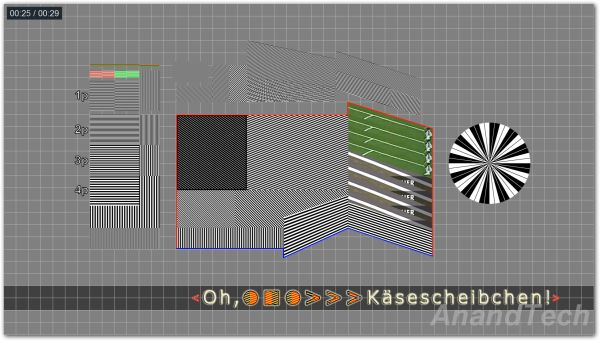Discrete HTPC GPU Shootout
by Ganesh T S on June 12, 2011 10:30 PM EST
Mismatches in the display refresh rate and source frame rate are difficult to spot for the average HTPC user, particularly if the dropped or repeated frames are far apart. Bad deinterlacing performance, on the other hand, may easily ruin the HTPC experience even for the average user. From DVDs to recorded TV shows and even Blu-ray documentaries, interlaced content is quite common.
We have been using the Cheese Slices test to check up on deinterlacing performance in the past. Instead of just covering the cheese slice alone, we will present a set of four consecutive deinterlaced frames from the video for you to judge.
Before presenting the results, let us take a look at how the ideal deinterlacing output should look like (a screenshot from the progressive version of the Cheese Slices clip around the same timestamp)
Click for Lossless Version
NVIDIA GT 430 Cheese Slices Deinterlacing:
MSI GT 520 Cheese Slices Deinterlacing:
AMD 6450 Cheese Slices Deinterlacing:
MSI 6450 Cheese Slices Deinterlacing:
Sapphire 6570 Cheese Slices Deinterlacing:
The Cheese Slices test is an artificial test clip. To bring some real world perspective to the deinterlacing performance, let us take a look at some screenshots of the 'Ship' clip from the Spears and Munsil High Definition Benchmark Test Disc (hereon referred to as the S&M clip). It is supposed to test the edge adaptive deinterlacing capabilities of the GPU. Note the jaggies in the various ropes in the screenshot. Roll the mouse over the various GPUs in the list below the image to see how each candidate performs.

| MSI GT 520 | MSI 6450 | NVIDIA GT 430 | Sapphire 6570 |
Pay particular attention to the deinterlacing performance of the GT 520. Compared to the other 4 cards in the test, this one emerges as the worst of the lot in the Cheese Slices test as well as the real world video test. When this was brought to NVIDIA's attention, they indicated the lack of shaders on the GF119 as the main reason for this issue. It looks like driver updates are not going to solve the issue in the future either. This is a big letdown for the prospective customers of the GT 520. Even though the deinterlacing performance of the GT 430 looks pretty good, a closer look reveals that it is not as effective as AMD's vector adaptive deinterlacing strategy.
On the AMD side, it looks like the reduced core clock frequency and lessened DRAM bandwidth of the MSI 6450 doesn't affect the deinterlacing performance in the Cheese Slices test. Vector adaptive deinterlacing works across all the cards in the 6xxx lineup. However, AMD has admitted to some driver issues for local file playback in the DDR3 based 6450s. This is probably the reason for the bad performance of the MSI 6450 in the S&M ship clip above. In an informal blind test, a majority seemed to prefer the 6570's output in the clip above, but you can decide for yourself.
The Catalyst Control Center allows users to experiment with different deinterlacing algorithms, while NVIDIA's Control Center doesn't. Admittedly, this choice of deinterlacing algorithms is of academic interest only. That said, the bad deinterlacing performance of the GT 520 and the fact that it is not going to improve in the future forces us to declare AMD the winner in this area.































70 Comments
View All Comments
jwilliams4200 - Monday, June 13, 2011 - link
All the numbers add up correctly now. Thanks for monitoring the comments and fixing the errors!Samus - Monday, June 13, 2011 - link
Honestly, my Geforce 210 has been chillin' in my HTPC for 2+ years, and works perfectly :)josephclemente - Monday, June 13, 2011 - link
If I am running a Sandy Bridge system with Intel HD Graphics 3000, do these cards have any benefit over integrated graphics? What is Anandtech's HQV Benchmark score?I tried searching for scores, but people say this is subjective and one reviewer may differ from another. One site says 196 and another in the low 100's. What does this reviewer say?
ganeshts - Monday, June 13, 2011 - link
Give me a couple of weeks. I will be getting a test system soon with the HD 3000, and I will do detailed HQV benchmarking in that review too.dmsher99@gmail.com - Tuesday, June 14, 2011 - link
I recently built a HTPC with a core i5-2500k on a ASUS P8H67 EVO with a Ceton InfiniTV cable card. Note that the Intel driver is fundamentally flawed and will destroy a system if patched. See the Intel communities thread 20439 for more details.Besides causing BSOD over HDMI output when patched, the stable versions have their own sets of bugs including a memory bleed when watching some premium content on HD channels that crashed WMC. Intel appears to have 1 part time developer working on this problem but every test river he puts out breaks more than it fixes. Watching the same, content with a system running a NVIDIA GPU and the memory bleed goes away.
In my opinion, second gen SB chips is just not ready for prime time in a fully loaded HTPC.
jwilliams4200 - Monday, June 13, 2011 - link
"The first shot shows the appearance of the video without denoising turned on. The second shot shows the performance with denoising turned off. "Heads I win, tails you lose!
ganeshts - Monday, June 13, 2011 - link
Again, sorry for the slip-up, and thanks for bringing it to our notice. Fixed it. Hopefully, the gallery pictures cleared up the confusion (particularly the Noise Reduction entry in the NVIDIA Control Panel)stmok - Monday, June 13, 2011 - link
Looking through various driver release README files, it appears the mobile Nvidia Quadro NVS 4200M (PCI Device ID: 0x1056) also has this feature set.The first stable Linux driver (x86) to introduce support for Feature Set D is 270.41.03 release.
=> ftp://download.nvidia.com/XFree86/Linux-x86/270.41...
It shows only the Geforce GT 520 and Quadro NVS 4200M support Feature Set D.
The most recent one confirms that they are still the only models to support it.
=> ftp://download.nvidia.com/XFree86/Linux-x86/275.09...
ganeshts - Monday, June 13, 2011 - link
Thanks for bringing it to our notice. When that page was being written (around 2 weeks back), the README indicated that the GT 520 was the only GPU supporting Feature Set D. We will let the article stand as-is, and I am sure readers perusing the comments will become aware of this new GPU.havoti97 - Monday, June 13, 2011 - link
So basically the app store's purpose is to attract submissions of ideas for features of their next OS, uncompensated of course. All the other crap/fart apps not worthy are approved and people make pennies of those.